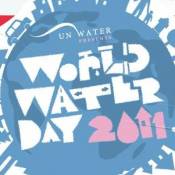Cities Central on World Water Day
With 141 million urban residents worldwide lacking access to drinking water, World Water Day focused on the strain water supplies are feeling with growing populations. The day allowed governments, organizations and corporations to highlight the innovative projects implemented around the world to assist cities as they combat the problems.

With 141 million urban residents worldwide lacking access to drinking water, World Water Day focused on the strain water supplies are feeling with growing populations. The day allowed governments, organizations and corporations to highlight the innovative projects implemented around the world to assist cities as they combat the problems.
22 March 2011 | If all the world’s water could fit inside a gallon jug, the amount available for drinking would be a tablespoon. And the demand for that tablespoon is only growing along with the cities of the world.
That’s why cities from Dar es Salaam in Tanzania to Heredia in Costa Rica and Denver in the United States are exploring the use of market-based programs that harness the buying power of cities to maintain the watersheds upon which those cities’ water sources depend.
It’s also why this year’s World Water Day, which took place Tuesday, made its theme “Water for Cities: Responding to the Urban Challenge”. According to WHO/UNICEF’s Joint Monitoring Programme, 141 million urban residents worldwide lack access to drinking water.
That number will continues to grow, and with it the pressure on watersheds that feed the cities. Toxic runoff has increased as farms replace natural buffers and wetlands, while poorly-regulated urban sprawl and industry poison urban water from within. As cash-strapped governments combat these issues, market-based solutions and compensation mechanisms are proving especially effective tools.
The Problem
“We know that by 2050, about half of the world will be living under extreme water stress with demand outstripping supply,” says Ahmed Djoghlaf, the chairman of the Convention on Biological Diversity in a statement released today. He also notes that climate change will intensify cities’ vulnerability to extremes in water.
But there’s hope. Communities around the world are engaged in innovative projects to ensure long-term access to drinking water. One of the key aspects of these projects is securing sustainable financing options.
“Limited water financing is one of the primary obstacles to improving access to clean water for millions of people throughout the world,” says USAID’s Global Waters. “Finding diverse and sustainable water financing is never a luxury and always a necessity.”
Engaging in water markets might be one solution for the lack of financing. Corporations and communities can engage in these types of solutions for the benefit of all—but before diving into these markets, corporations want to know how to get the most bang for their buck.
Managing Water Supply
While it may seem that building innovative water purification systems might be just that, corporations should look outside the city for the most sustainable options.
“It is true that climate change and increasing demand will outstrip safe and reliable sources if we continue down the current path,” writes Joe Geever of the Surfrider Foundation in an article published today. “However, the problem is not a ‘supply crisis,’ but instead a ‘water management’ crisis.”
Management can involve anything from better water infrastructure to a greater emphasis on watershed planning
Within cities, investing in ‘green infrastructure’ like porous pavements, green roofs, and rainwater barrels can slow storm water runoff, filter out pollutants, and capture the water for reuse or groundwater recharge. A new UNEP report on Monday called for a bigger emphasis on green infrastructure in urban areas in Africa to ensure that access to clean water keeps pace with explosive population growth.
However, the most cost-effective solution for water quality and supply is emphasizing watershed and ecosystem management.
“Fortunately, maintaining the integrity of rich ecosystems such as forests and wetlands which surround cities is a cost-effective way to ensure water security and water quality,” says Djoghlaf. “Ecosystems underpin water security in terms of both the quantity and quality of available water, as well as protecting populations against water-related natural disasters.”
Though Djoghlaf noted that developing countries are going to the ones most affected by water availability, developed countries also have increased demand on their water supply.
In the United States, cities are engaged in market solutions that protect watersheds and ensure sufficient water supply. For example, the city of Denver engaged in a $33 million deal with the US Forest Service, utilizing water fees to ensure the protection and maintenance of the surrounding watershed . In New York City, the that provide a filtering system for their drinking water.
However, as a poll released today notes, many Americans do not realize the essential nature that forests serve in ensuring the quality and quantity of water in cities. In fact, 75% of Americans do not know where their water comes from. The US Forest Service is working to increase people’s awareness, creating maps entitled “Forests, Water and People” which highlights watersheds that a large population relies on (Read more in Mapping the Value of Watershed Services).
World Water Day is a once-a-year reminder of the essential role that water plays in everyone’s lives and the importance of sustainable management of this precious resource. It raises awareness that nature’s infrastructure provides a sustainable source of clean water that must be cared for by the those who rely on it. It also highlights the need for innovative thinking among governments, policy makers and practitioners for sustainable solutions to better meet the demands of growing urban populations.
Additional resources
Please see our Reprint Guidelines for details on republishing our articles.

